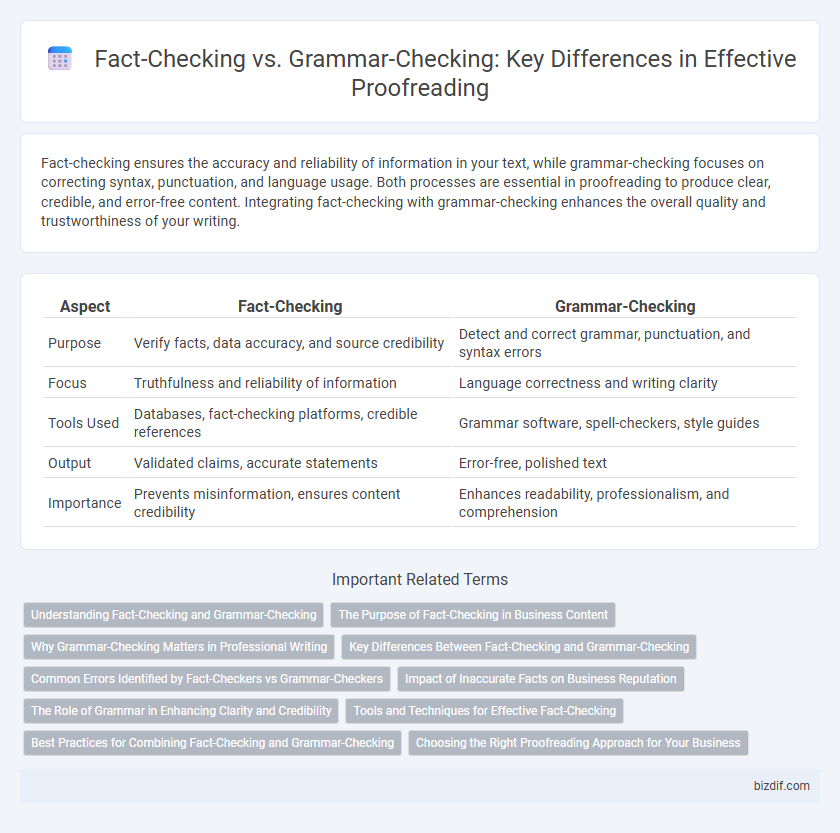Fact-checking ensures the accuracy and reliability of information in your text, while grammar-checking focuses on correcting syntax, punctuation, and language usage. Both processes are essential in proofreading to produce clear, credible, and error-free content. Integrating fact-checking with grammar-checking enhances the overall quality and trustworthiness of your writing.
Table of Comparison
| Aspect | Fact-Checking | Grammar-Checking |
|---|---|---|
| Purpose | Verify facts, data accuracy, and source credibility | Detect and correct grammar, punctuation, and syntax errors |
| Focus | Truthfulness and reliability of information | Language correctness and writing clarity |
| Tools Used | Databases, fact-checking platforms, credible references | Grammar software, spell-checkers, style guides |
| Output | Validated claims, accurate statements | Error-free, polished text |
| Importance | Prevents misinformation, ensures content credibility | Enhances readability, professionalism, and comprehension |
Understanding Fact-Checking and Grammar-Checking
Fact-checking involves verifying the accuracy and truthfulness of information within a text, ensuring that all claims are supported by credible sources and evidence. Grammar-checking focuses on identifying and correcting errors in syntax, punctuation, spelling, and sentence structure to improve clarity and readability. Both processes enhance the overall quality of writing by addressing different aspects--fact-checking maintains content integrity, while grammar-checking polishes language mechanics.
The Purpose of Fact-Checking in Business Content
Fact-checking in business content ensures the accuracy and credibility of information, preventing the spread of misinformation that can damage brand reputation and erode customer trust. This process verifies data, statistics, dates, and claims against reliable sources, supporting informed decision-making and maintaining professional integrity. Unlike grammar-checking, which focuses solely on language correctness, fact-checking safeguards the content's factual authenticity essential for effective communication.
Why Grammar-Checking Matters in Professional Writing
Grammar-checking ensures clarity and professionalism in written communication, preventing misunderstandings and maintaining the credibility of the author or organization. It detects errors in syntax, punctuation, and sentence structure that fact-checking cannot identify, enhancing overall readability and engagement. In professional writing, flawless grammar reinforces authority and fosters trust with readers, which is essential for effective information dissemination.
Key Differences Between Fact-Checking and Grammar-Checking
Fact-checking verifies the accuracy and credibility of information, ensuring all data and statements are true and reliable. Grammar-checking focuses on the correctness of language, including syntax, punctuation, and spelling errors to improve readability. Fact-checking prevents misinformation, while grammar-checking enhances communication clarity.
Common Errors Identified by Fact-Checkers vs Grammar-Checkers
Fact-checkers commonly identify errors related to inaccurate data, false claims, and misrepresented statistics, ensuring content reliability and truthfulness. Grammar-checkers focus on correcting syntax mistakes, punctuation errors, and improper sentence structure to enhance readability and linguistic accuracy. Together, these tools complement each other by addressing both factual integrity and language correctness in written materials.
Impact of Inaccurate Facts on Business Reputation
Inaccurate facts can severely damage a business's reputation by eroding customer trust and leading to misinformation that affects decision-making. Fact-checking ensures the accuracy and reliability of content, which protects brand integrity and maintains stakeholder confidence. Grammar-checking, while essential for professionalism, does not address the critical impact of factual errors on credibility and business outcomes.
The Role of Grammar in Enhancing Clarity and Credibility
Grammar-checking ensures sentence structure, punctuation, and syntax are correct, enhancing readability and professional tone, which directly boosts a text's clarity and credibility. Fact-checking verifies the accuracy of information, reinforcing the trustworthiness of content but does not address linguistic precision. Proper grammar usage supports the clear communication of facts, making the content more convincing and authoritative to readers.
Tools and Techniques for Effective Fact-Checking
Effective fact-checking relies on specialized tools such as fact-checking databases, reverse image search engines, and AI-powered verification platforms that cross-reference information with credible sources. Techniques include verifying source credibility, checking publication dates, and using multiple independent sources to confirm facts. Combining these tools with critical analysis ensures accurate and trustworthy content beyond basic grammar-checking capabilities.
Best Practices for Combining Fact-Checking and Grammar-Checking
Integrating fact-checking with grammar-checking ensures the accuracy and clarity of content by verifying information sources alongside language correctness. Utilizing advanced proofreading tools that combine semantic analysis with database cross-referencing optimizes the detection of factual errors and grammatical mistakes simultaneously. Establishing a workflow that prioritizes fact verification before final grammar review enhances the credibility and professionalism of the written material.
Choosing the Right Proofreading Approach for Your Business
Fact-checking ensures the accuracy and credibility of your business content by verifying data, dates, and statements with reliable sources, while grammar-checking focuses on correcting syntax, punctuation, and language usage to enhance readability and professionalism. Selecting the right proofreading approach depends on your business goals; precise fact-checking is essential for industries reliant on data integrity like finance and healthcare, whereas grammar-checking is crucial for marketing materials and client communications to maintain polished presentation. Integrating both methods into your proofreading workflow maximizes content quality, builds customer trust, and supports strong brand reputation.
Fact-checking vs Grammar-checking Infographic

 bizdif.com
bizdif.com